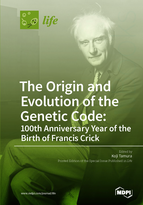The Origin and Evolution of the Genetic Code: 100th Anniversary Year of the Birth of Francis Crick
A special issue of Life (ISSN 2075-1729). This special issue belongs to the section "Genetics and Genomics".
Deadline for manuscript submissions: closed (15 January 2017) | Viewed by 93265
Special Issue Editor
Special Issue Information
Dear Colleagues,
The genetic code is one of the greatest discoveries of the 20th century as it is central to life itself. It is the algorithm that connects 64 RNA triplets to 20 amino acids, thus functioning as the Rosetta Stone of molecular biology.
Following the discovery of the structure of DNA by James Watson and Francis Crick in 1953, George Gamow organized the 20-member “RNA Tie Club” to discuss the transmission of information by DNA. Crick, Sydney Brenner, Leslie Barnett, and Richard Watts-Tobin first demonstrated the three bases of DNA code for one amino acid. The decoding of the genetic code was begun by Marshall Nirenberg and Heinrich Matthaei and was finally completed by Har Gobind Khorana.
In the mid-1960s, Carl Woese proposed the “stereochemical hypothesis”, which speculated that the genetic code derives from a type of codon–amino acid-pairing interaction. On the other hand, Crick proposed the “frozen accident hypothesis” and conjectured that the genetic code evolved from the last common universal ancestor and was frozen once established. However, he explicitly left room for stereochemical interactions between amino acids and their coding nucleotides, stating that “It is therefore essential to pursue the stereochemical theory…vague models of such interactions are of little use. What is wanted is direct experimental proof that these interactions take place…and some idea of their specificity.”
The origin and evolution of the genetic code remains a mystery despite numerous theories and attempts to understand these. In this Special Issue, experts in the field will present their thoughts and views on this topic. The scope of this Special Issue shall encompass not only experimental analyses, but also hypotheses and theoretical trials. Additionally, because 2016 commemorates the 100th anniversary of the birth of Francis Crick, the discoverer of the genetic code, historical commentaries on him are also welcome.
Prof. Dr. Koji Tamura
Guest Editor
Manuscript Submission Information
Manuscripts should be submitted online at www.mdpi.com by registering and logging in to this website. Once you are registered, click here to go to the submission form. Manuscripts can be submitted until the deadline. All submissions that pass pre-check are peer-reviewed. Accepted papers will be published continuously in the journal (as soon as accepted) and will be listed together on the special issue website. Research articles, review articles as well as short communications are invited. For planned papers, a title and short abstract (about 100 words) can be sent to the Editorial Office for announcement on this website.
Submitted manuscripts should not have been published previously, nor be under consideration for publication elsewhere (except conference proceedings papers). All manuscripts are thoroughly refereed through a single-blind peer-review process. A guide for authors and other relevant information for submission of manuscripts is available on the Instructions for Authors page. Life is an international peer-reviewed open access monthly journal published by MDPI.
Please visit the Instructions for Authors page before submitting a manuscript. The Article Processing Charge (APC) for publication in this open access journal is 2600 CHF (Swiss Francs). Submitted papers should be well formatted and use good English. Authors may use MDPI's English editing service prior to publication or during author revisions.
Keywords
- genetic code
- stereochemistry
- frozen accident
- codon
- anticodon
- amino acid
- tRNA
- aminoacyl tRNA synthetase
- specificity
- Francis Crick







